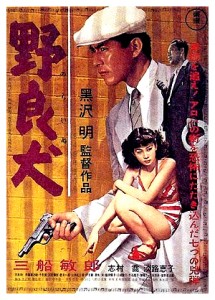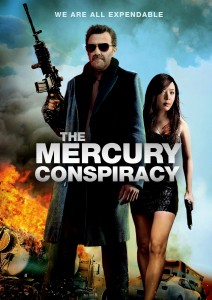cityonfire.com | Movie News & Developments |
| Posted: 25 Jun 2015 10:43 PM PDT Director: Akira Kurosawa By Matthew Le-feuvre At a time when social or political ambivalence wasn’t an option to explore or express through art – or by any other visual medium – acclaimed Japanese filmmaker, Akira Kurosawa, then under contract with the Toho film studios, was one of a select few who took a noble stance at edifying post war audiences with personal features like: The Judo Saga (1943), The Most Beautiful (1944), The Men Who Tread on the Tiger’s Tail (1945) and Drunken Angel (1948). And despite censorship from an American occupational body, these pictures were structured to both preserve and cultivate an awareness of Japanese national identity, while concurrently reconciling with the savage realities of Nagasaki and Hiroshima. Unlike his contemporaries, Kurosawa appeared to be something of a political chameleon: in one instance during a drunken stupor in the company of Andrei Konchalovsky, he allegedly praised Lenin for his Communist policies – somewhat eccentric, and totally against character for an artist/filmmaker who deliberately chose to illustrate and promote non-conformity, especially in challenging bureaucracy of all kinds because he himself was from a middle class samurai background. Yet for many – including Hollywood’s elite: George Lucas, Steven Spielberg and Francis Ford Coppola – Kurosawa remains an emblem of pure genius whose technical innovations resonate a visual style which even by current paradigms is unsurpassed. Nevertheless, it wasn’t always about technicality; character development was just as important as Kurosawa’s fascination with the human condition: particularly the study of the ‘lone archetype’ as presented in his seminal ‘ronin’ masterpieces Yojimbo (1961) and Sanjuro (1962), where customized traits of suspense-building, raw emotion and explicit sword choreography were all majestically weaved together on a rich celluloid tapestry that was far more appealing in the western hemisphere than in homegrown Japan. This was, in part, due to Kurosawa’s preoccupation with (largely) ‘Western’ filmmaker, John Ford (1895-1973); another contemporary and a relatively older breed of maverick who invariably defied studio executives with his preference for casting stalwart, John Wayne in many of his own productions. Again, Kurosawa followed suit often fighting for, or opting to select, comparatively inexperienced unknowns such as renowned, intensely versatile, Toshiro Mifune, who went on to help revolutionize Japanese cinema with extraordinary performances in: The Seven Samurai (1954) – remade or reenvision numerous times – Throne of Blood (1957) and The Hidden Fortress (1958); the latter inspiring Lucas’ A New Hope (1977) segment of his ongoing Star Wars anthology. While Drunken Angel (1948) was raw and, at intervals, uncompromising, Stray Dog (Kurosawa’s follow-up picture with Mifune) is more of an allegory piece than a straight forward detective chase thriller. Yes! An element of noir influences from Frank Tuttle (This Gun For Hire) to Jacques Tourneur (Build My Gallows High) are recognizable at the outset, noticeably made more real by a feeling of oppression, firstly from a sweltering heat wave; which, psychologically, is just as uncomfortable for the viewer as was in all probability for the cast. (And) secondly, Toshiro Mifune’s character is almost represented as a lost soul in a neon-lit hades that is Tokyo – a symbolic, and in essence, ‘corrupt’ macrocosm, by night – yet in daylight hours – embarrassingly depicts overcrowding, poverty and refugees juxtaposed to an extant sense of cynicism which permeates every alleyway, town dwelling or high-rise apartment. Equally, devastation is not solely concentrated upon Tokyo’s infrastructure, but ubiquitously within the heart of all citizens yearning to better themselves socially, materialistically and/or spiritually. On the surface, the premise (based on Kurosawa’s own unpublished novel) of Stray Dog was as ‘simplistic’ as you could get: however beneath its external, unconventional post-WWII moulding lies a very complex, thoughtfully realized project that – despite occasionally confounding, even frustrating – its maker begins with the theft of a police issue gun owned by a former soldier-turned-detective named Murakami (Toshiro Mifune). Enterprisingly, this instrument of law enforcement becomes an extension of death as Murakami’s gun is sold through an illegal black market, and is eventually passed onto psychopath, Shinjuro Yusa (Isao Ko Kimura), who incrementally leaves a trail of murder and confusion just to impress his sponging, morally vacant girlfriend, Harumi Namaki (Keiko Anaji). Overwhelmed with guilt, Murakami naturally questions his competency, while doubly intent on catching Yusa dead or alive – a broad view that mildly clashes with his more seasoned superior, chief detective Sato (an award-winning Takashi Shimura), whose passively inclined, almost philosophical, ethics nearly costs him his life during a (subsequent) chance encounter with Yusa at a boarding house. However there appears to be a methodology to Yusa’s violent dementia, and the grand old question is subtly put forward as to whether killers are born, or manufactured by a series of societal interactions/incidents: a typification unknowingly conceived (or perceived), even perpetuated out of ignorant vulgarity. In a climax clearly indicative of Hitchcock, Lang or Preminger, Murakami pursues Yusa to a rural railway station. It is here in a darkly ironic, yet intense, multi-edited sequence, the claustrophobia of a lively waiting room amplifies Murakami’s desperation as he fails to identify Yusa (as does the audience) from the description given to him. Ultimately, the railway station randomly transforms into an arena; a battleground of wits, observation, adrenaline, as well as razor sharp reflexes: all in accord will ordain closure for one of them… but who?! Verdict: No hint of ‘Noh’ or ‘Kabuki’ motifs whatsoever, Stray Dog was the least favourite of Kurosawa’s productions as he felt it was “too technical!” Regardless of this self criticism, characters are defined irrespective of controversy, while pivotal messages are concealed just barely beneath an organized narrative, and like Murakami, we first repudiate – even prejudge who’s good, who’s evil, without fully understanding the totality of ’cause and effect’: a liberating perception Kurosawa was relentlessly communicating in a nontraditional way through his own inspirations, topics, imagery and concepts. Matthew Le-feuvre’s Rating: 10/10 |
| The Mercury Conspiracy | DVD (Entertainment One) Posted: 25 Jun 2015 09:34 PM PDT Entertainment One presents the DVD for The Mercury Conspiracy (aka The Mercury Factor), directed by and starring Luca Barbareschi (Cannibal Holocaust). After her son dies from poisoned food, Xiwen falls in love with Matteo, a businessman. Though a good man at heart, Matteo has been lured into the black market trafficking of adulterated food – the same food responsible for killing Xiwen’s son! This Italian film is noted for its heavy Chinese cast, including Jingchu Zhang (Switch), Carl Ng (New Police Story), Kenneth Tsang (The Killer), Michael Wong (Zombie Fight Club) and Eddie Ko (Heroes Shed No Tears). | Watch the trailer. Pre-order The Mercury Conspiracy from Amazon.com today! |
| You are subscribed to email updates from cityonfire.com | Movie News & Developments To stop receiving these emails, you may unsubscribe now. | Email delivery powered by Google |
| Google Inc., 1600 Amphitheatre Parkway, Mountain View, CA 94043, United States | |



No comments:
Post a Comment